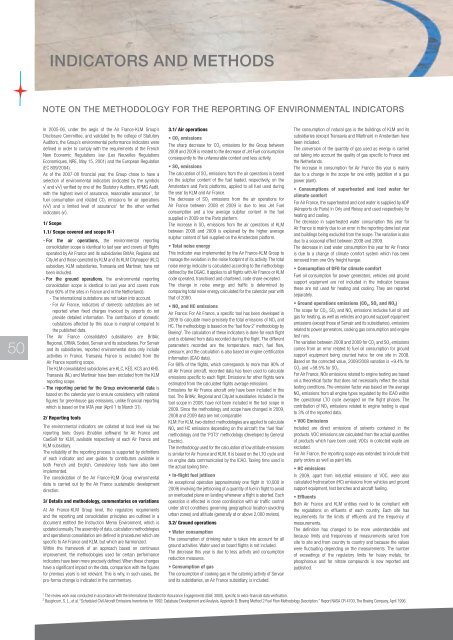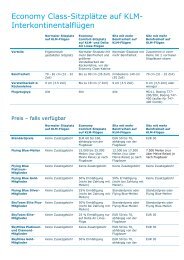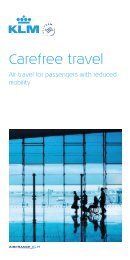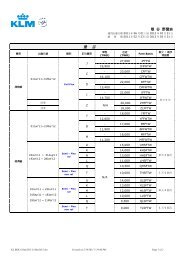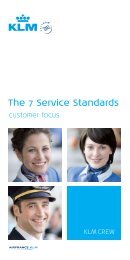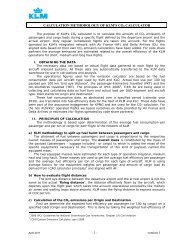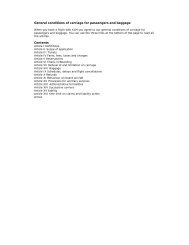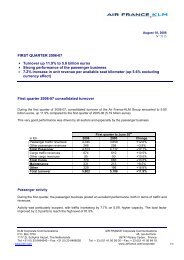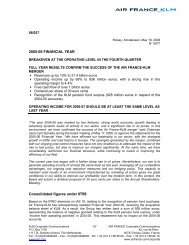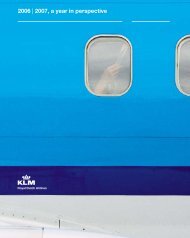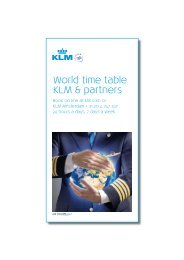CORPORATE SOCIAL RESPONSIBILITY REPORT 2009-10
CORPORATE SOCIAL RESPONSIBILITY REPORT 2009-10
CORPORATE SOCIAL RESPONSIBILITY REPORT 2009-10
Create successful ePaper yourself
Turn your PDF publications into a flip-book with our unique Google optimized e-Paper software.
50<br />
INDICATORS AND METHODS<br />
NOTE ON THE METHODOLOGY FOR THE <strong>REPORT</strong>ING OF ENVIRONMENTAL INDICATORS<br />
In 2005-06, under the aegis of the Air France-KLM Group’s<br />
Disclosure Committee, and validated by the college of Statutory<br />
Auditors, the Group’s environmental performance indicators were<br />
defined in order to comply with the requirements of the French<br />
New Economic Regulations law (Les Nouvelles Regulations<br />
Economiques, NRE, May 15, 2001) and the European Regulation<br />
(EC 809/2004).<br />
As of the 2007-08 financial year, the Group chose to have a<br />
selection of environmental indicators (indicated by the symbols<br />
√ and √√) verified by one of the Statutory Auditors, KPMG Audit,<br />
with the highest level of assurance, reasonable assurance 1 , for<br />
fuel consumption and related CO 2 emissions for air operations<br />
(√√) and a limited level of assurance 1 for the other verified<br />
indicators (√).<br />
1/ Scope<br />
1.1/ Scope covered and scope N-1<br />
- For the air operations, the environmental reporting<br />
consolidation scope is identical to last year and covers all flights<br />
operated by Air France and its subsidiaries BritAir, Regional and<br />
CityJet and those operated by KLM and its KLM Cityhopper (KLC)<br />
subsidiary. KLM subsidiaries, Transavia and Martinair, have not<br />
been included.<br />
- For the ground operations, the environmental reporting<br />
consolidation scope is identical to last year and covers more<br />
than 90% of the sites in France and in the Netherlands:<br />
- The international outstations are not taken into account.<br />
- For Air France, indicators of domestic outstations are not<br />
reported when fixed charges invoiced by airports do not<br />
provide detailed information. The contribution of domestic<br />
outstations affected by this issue is marginal compared to<br />
the published data.<br />
• The Air France consolidated subsidiaries are BritAir,<br />
Regional, CRMA, Sodexi, Servair and its subsidiaries. For Servair<br />
and its subsidiaries, reported environmental data only include<br />
activities in France. Transavia France is excluded from the<br />
Air France reporting scope.<br />
• The KLM consolidated subsidiaries are KLC, KES, KCS and KHS.<br />
Transavia (NL) and Martinair have been excluded from the KLM<br />
reporting scope.<br />
- The reporting period for the Group environmental data is<br />
based on the calendar year to ensure consistency with national<br />
figures for greenhouse gas emissions, unlike financial reporting<br />
which is based on the IATA year (April 1 to March 31).<br />
2/ Reporting tools<br />
The environmental indicators are collated at local level via two<br />
reporting tools: Osyris (Enablon software) for Air France and<br />
CaeSaR for KLM, available respectively at each Air France and<br />
KLM subsidiary.<br />
The reliability of the reporting process is supported by definitions<br />
of each indicator and user guides to contributors available in<br />
both French and English. Consistency tests have also been<br />
implemented.<br />
The consolidation of the Air France-KLM Group environmental<br />
data is carried out by the Air France sustainable development<br />
direction.<br />
3/ Details and methodology, commentaries on variations<br />
At Air France-KLM Group level, the regulatory requirements<br />
and the reporting and consolidation principles are outlined in a<br />
document entitled the Instruction Memo Environment, which is<br />
updated annually. The assembly of data, calculation methodologies<br />
and operational consolidation are defined in procedures which are<br />
specific to Air France and KLM, but which are harmonized.<br />
Within the framework of an approach based on continuous<br />
improvement, the methodologies used for certain performance<br />
indicators have been more precisely defined. When these changes<br />
have a significant impact on the data, comparison with the figures<br />
for previous years is not relevant. This is why, in such cases, the<br />
pro-forma change is indicated in the commentary.<br />
3.1/ Air operations<br />
• CO2 emissions<br />
The sharp decrease for CO2 emissions for the Group between<br />
2008 and <strong>2009</strong> is related to the decrease of Jet Fuel consumption<br />
consequently to the unfavourable context and less activity.<br />
• SO2 emissions<br />
The calculation of SO2 emissions from the air operations is based<br />
on the sulphur content of the fuel loaded, respectively, on the<br />
Amsterdam and Paris platforms, applied to all fuel used during<br />
the year by KLM and Air France.<br />
The decrease of SO2 emissions from the air operations for<br />
Air France between 2008 et <strong>2009</strong> is due to less Jet Fuel<br />
consumption and a low average sulphur content in the fuel<br />
supplied in <strong>2009</strong> on the Paris platform.<br />
The increase in SO2 emissions from the air operations of KLM<br />
between 2008 and <strong>2009</strong> is explained by the higher average<br />
sulphur content of fuel supplied on the Amsterdam platform.<br />
• Total noise energy<br />
This indicator was implemented by the Air France-KLM Group to<br />
manage the evolution in the noise footprint of its activity. The total<br />
noise energy indicator is calculated according to the methodology<br />
defined by the DGAC. It applies to all flights with Air France or KLM<br />
code operated, franchised and chartered, code share excepted.<br />
The change in noise energy and traffic is determined by<br />
comparing total noise energy calculated for the calendar year with<br />
that of 2000.<br />
• NOx and HC emissions<br />
Air France: For Air France, a specific tool has been developed in<br />
<strong>2009</strong> to calculate more precisely the total emissions of NOX and<br />
HC. The methodology is based on the ‘fuel flow 2’ methodology by<br />
Boeing2 . The calculation of these indicators is done for each flight<br />
and is obtained from data recorded during the flight. The different<br />
parameters recorded are the temperature, mach, fuel flow,<br />
pressure, and the calculation is also based on engine certification<br />
information (ICAO data).<br />
For 68% of the flights, which corresponds to more than 90% of<br />
all Air France aircraft, recorded data has been used to calculate<br />
emissions specific to each flight. Emissions for other flights were<br />
estimated from the calculated flights average emissions.<br />
Emissions for Air France aircraft only have been included in this<br />
tool. The BritAir, Regional and CityJet subsidiaries included in the<br />
tool scope in 2008, have not been included in the tool scope in<br />
<strong>2009</strong>. Since the methodology and scope have changed in <strong>2009</strong>,<br />
2008 and <strong>2009</strong> data are not comparable.<br />
KLM: For KLM, two distinct methodologies are applied to calculate<br />
NOX and HC emissions depending on the aircraft: the ‘fuel flow’<br />
methodology and the ‘P3T3’ methodology (developed by General<br />
Electric).<br />
The methodology used for the calculation of low altitude emissions<br />
is similar for Air France and KLM. It is based on the LTO cycle and<br />
on engine data communicated by the ICAO. Taxiing time used is<br />
the actual taxiing time.<br />
• In-flight fuel jettison<br />
An exceptional operation (approximately one flight in <strong>10</strong>,000 in<br />
<strong>2009</strong>) involving the jettisoning of a quantity of fuel in flight to avoid<br />
an overloaded plane on landing whenever a flight is aborted. Each<br />
operation is effected in close coordination with air traffic control<br />
under strict conditions governing geographical location (avoiding<br />
urban zones) and altitude (generally at or above 2,000 meters).<br />
3.2/ Ground operations<br />
• Water consumption<br />
The consumption of drinking water is taken into account for all<br />
ground activities. Water used on board flights is not included.<br />
The decrease this year is due to less activity and consumption<br />
reduction measures.<br />
• Consumption of gas<br />
The consumption of cooking gas in the catering activity of Servair<br />
and its subsidiaries, an Air France subsidiary, is included.<br />
The consumption of natural gas is the buildings of KLM and its<br />
subsidiaries (except Transavia and Martinair) in Amsterdam have<br />
been included.<br />
The conversion of the quantity of gas used as energy is carried<br />
out taking into account the quality of gas specific to France and<br />
the Netherlands.<br />
The increase in consumption for Air France this year is mainly<br />
due to a change in the scope for one entity (addition of a gas<br />
power plant).<br />
• Consumptions of superheated and iced water for<br />
climate comfort<br />
For Air France, the superheated and iced water is supplied by ADP<br />
(Aéroports de Paris) in Orly and Roissy and used respectively for<br />
heating and cooling.<br />
The decrease in superheated water consumption this year for<br />
Air France is mainly due to an error in the reporting done last year<br />
and buildings being excluded from the scope. The variation is also<br />
due to a seasonal effect between 2008 and <strong>2009</strong>.<br />
The decrease in iced water consumption this year for Air France<br />
is due to a change of climate comfort system which has been<br />
removed from one Orly freight hangar.<br />
• Consumption of DFO for climate comfort<br />
Fuel oil consumption for power generators, vehicles and ground<br />
support equipment are not included in the indicator because<br />
these are not used for heating and cooling. They are reported<br />
separately.<br />
• Ground operations emissions (CO 2, SO 2 and NO X)<br />
The scope for CO 2, SO 2 and NO X emissions includes fuel oil and<br />
gas for heating, as well as vehicles and ground support equipment<br />
emissions (except those of Servair and its subsidiaries), emissions<br />
related to power generators, cooking gas consumption and engine<br />
test runs.<br />
The variation between 2008 and <strong>2009</strong> for CO 2 and SO 2 emissions<br />
comes from an error related to fuel oil consumption for ground<br />
support equipment being counted twice for one site in 2008.<br />
Based on the corrected value, <strong>2009</strong>/2008 variation is +9.4% for<br />
CO 2 and +58.5% for SO 2.<br />
For Air France, NOx emissions related to engine testing are based<br />
on a theoretical factor that does not necessarily reflect the actual<br />
testing conditions. The emission factor was based on the average<br />
NO X emissions from all engine types regulated by the ICAO within<br />
the operational LTO cycle averaged on the flight phases. The<br />
contribution of NO X emissions related to engine testing is equal<br />
to 3% of the reported data.<br />
• VOC Emissions<br />
Included are direct emissions of solvents contained in the<br />
products. VOC emissions are calculated from the actual quantities<br />
of products which have been used; VOCs in collected waste are<br />
excluded.<br />
For Air France, the reporting scope was extended to include third<br />
party orders as well as paint kits.<br />
• HC emissions<br />
In <strong>2009</strong>, apart from industrial emissions of VOC, were also<br />
calculated hydrocarbon (HC) emissions from vehicles and ground<br />
support equipment, test benches and aircraft fueling.<br />
• Effluents<br />
Both Air France and KLM entities need to be compliant with<br />
the regulations on effluents of each country. Each site has<br />
requirements for the limits of effluents and the frequency of<br />
measurements.<br />
The definition has changed to be more understandable and<br />
because limits and frequencies of measurements varied from<br />
site to site and from country to country and because the values<br />
were fluctuating depending on the measurements. The number<br />
of exceedings of the regulatory limits for heavy metals, for<br />
phosphorous and for nitrate compounds is now reported and<br />
published.<br />
1 The review work was conducted in accordance with the International Standard for Assurance Engagements (ISAE 3000), specific to extra-financial data verification.<br />
2 Baughcum, S. L., et al. “Scheduled Civil Aircraft Emissions Inventories for 1992: Database Development and Analysis, Appendix D: Boeing Method 2 Fuel Flow Methodology Description.” Report NASA CR 4700, The Boeing Company, April 1996.


